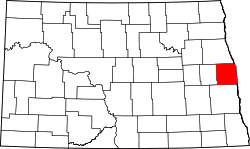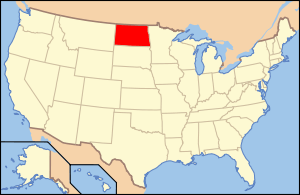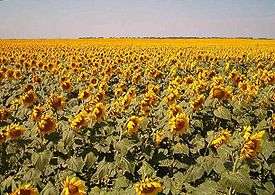Traill County, North Dakota
| Traill County, North Dakota | |
|---|---|
 | |
 Location in the U.S. state of North Dakota | |
 North Dakota's location in the U.S. | |
| Founded | February 23, 1875[1] |
| Seat | Hillsboro |
| Largest city | Mayville |
| Area | |
| • Total | 863 sq mi (2,235 km2) |
| • Land | 862 sq mi (2,233 km2) |
| • Water | 0.6 sq mi (2 km2), 0.07% |
| Population (est.) | |
| • (2015) | 8,014 |
| • Density | 9.4/sq mi (4/km²) |
| Congressional district | At-large |
| Time zone | Central: UTC-6/-5 |
| Website |
www |
Coordinates: 47°27′N 97°11′W / 47.450°N 97.183°W
Traill County is a county located in the U.S. state of North Dakota. As of the 2010 census listed the population at 8,121.[2] Its county seat is Hillsboro,[3] and its largest city is Mayville. The county was formed in 1875.[1][4]
History
Traill County was created in 1875 by the 1874-75 territorial legislature. It was named after Walter John Strickland Traill, an employee of the Hudson's Bay Company and son of Canadian pioneer Catharine Parr Traill.[1]
County headquarters were originally located in a small single-story building in Caledonia. Several replacement courthouses were built during the late 19th century and several votes to move the county seat to Mayville narrowly failed. Efforts to move the county seat to Hillsboro were more successful, and all county records were moved there in 1890.[5] The current Traill County Courthouse started construction in 1905 and is listed in the National Register of Historic Places.[6]
Geography
According to the U.S. Census Bureau, the county has a total area of 863 square miles (2,240 km2), of which 862 square miles (2,230 km2) is land and 0.6 square miles (1.6 km2) (0.07%) is water.[7]
Adjacent counties
- Grand Forks County (north)
- Polk County, Minnesota (northeast)
- Norman County, Minnesota (east)
- Cass County (south)
- Steele County (west)
Demographics
| Historical population | |||
|---|---|---|---|
| Census | Pop. | %± | |
| 1880 | 4,123 | — | |
| 1890 | 10,217 | 147.8% | |
| 1900 | 13,107 | 28.3% | |
| 1910 | 12,545 | −4.3% | |
| 1920 | 12,210 | −2.7% | |
| 1930 | 12,600 | 3.2% | |
| 1940 | 12,300 | −2.4% | |
| 1950 | 11,359 | −7.7% | |
| 1960 | 10,583 | −6.8% | |
| 1970 | 9,571 | −9.6% | |
| 1980 | 9,624 | 0.6% | |
| 1990 | 8,752 | −9.1% | |
| 2000 | 8,477 | −3.1% | |
| 2010 | 8,121 | −4.2% | |
| Est. 2015 | 8,014 | [8] | −1.3% |
| U.S. Decennial Census[9] 1790-1960[10] 1900-1990[11] 1990-2000[12] 2010-2015[2] | |||
2000 census
As of the census of 2010, there were 8,121 people, 3,341 households, and 2,231 families residing in the county. The population density was 10 persons per square mile (4/km²). There were 3,708 housing units at an average density of 4 per square mile (2/km²). The racial makeup of the county was 97.31% White, 0.11% Black or African American, 0.94% Native American, 0.15% Asian, 0.01% Pacific Islander, 0.96% from other races, and 0.52% from two or more races. 2.18% of the population were Hispanic or Latino of any race. 58.9% were of Norwegian and 20.6% German ancestry.
There were 3,341 households out of which 30.9% had children under the age of 18 living with them, 58.0% were married couples living together, 5.4% had a female householder with no husband present, and 33.2% were non-families. 29.3% of all households were made up of individuals and 15.10% had someone living alone who was 65 years of age or older. The average household size was 2.41 and the average family size was 3.00.
In the county the population was spread out with 24.8% under the age of 18, 9.7% from 18 to 24, 24.8% from 25 to 44, 21.6% from 45 to 64, and 19.1% who were 65 years of age or older. The median age was 39 years. For every 100 females there were 100.8 males. For every 100 females age 18 and over, there were 97.9 males.
The median income for a household in the county was $37,445, and the median income for a family was $45,852. Males had a median income of $30,138 versus $20,583 for females. The per capita income for the county was $18,014. About 6.4% of families and 9.2% of the population were below the poverty line, including 9.6% of those under age 18 and 8.1% of those age 65 or over.
2010 census
As of the 2010 United States Census, there were 8,121 people, 3,394 households, and 2,150 families residing in the county.[13] The population density was 9.4 inhabitants per square mile (3.6/km2). There were 3,780 housing units at an average density of 4.4 per square mile (1.7/km2).[14] The racial makeup of the county was 96.2% white, 0.8% American Indian, 0.5% black or African American, 0.3% Asian, 1.1% from other races, and 1.2% from two or more races. Those of Hispanic or Latino origin made up 2.6% of the population.[13] In terms of ancestry, 53.2% were Norwegian, 38.1% were German, 5.9% were Irish, and 2.6% were American.[15]
Of the 3,394 households, 27.6% had children under the age of 18 living with them, 54.2% were married couples living together, 6.2% had a female householder with no husband present, 36.7% were non-families, and 31.3% of all households were made up of individuals. The average household size was 2.29 and the average family size was 2.88. The median age was 42.6 years.[13]
The median income for a household in the county was $44,290 and the median income for a family was $60,054. Males had a median income of $39,846 versus $28,378 for females. The per capita income for the county was $23,340. About 4.6% of families and 9.2% of the population were below the poverty line, including 10.9% of those under age 18 and 11.1% of those age 65 or over.[16]
Transportation
Major highways
Airports
The following public-use airports are location in Traill County:
- Hillsboro Municipal Airport (3H4) in Hillsboro, North Dakota
- Mayville Municipal Airport (D56) in Mayville, North Dakota
Communities

Cities
Townships
- Belmont
- Bingham
- Blanchard
- Bloomfield
- Bohnsack
- Buxton
- Caledonia
- Eldorado
- Elm River
- Ervin
- Galesburg
- Garfield
- Greenfield
- Herberg
- Hillsboro
- Kelso
- Lindaas
- Mayville
- Morgan
- Norman
- Norway
- Roseville
- Stavanger
- Viking
- Wold
Census-designated places
Unincorporated communities
See also
Notes
- 1 2 3 "County History". North Dakota.gov. The State of North Dakota. Retrieved February 4, 2015.
- 1 2 "State & County QuickFacts". United States Census Bureau. Retrieved November 1, 2013.
- ↑ "Find a County". National Association of Counties. Retrieved 2011-06-07.
- ↑ "Dakota Territory, South Dakota, and North Dakota: Individual County Chronologies". Dakota Territory Atlas of Historical County Boundaries. The Newberry Library. 2006. Retrieved February 4, 2015.
- ↑ "Traill County, North Dakota". Retrieved January 30, 2012.
- ↑ National Park Service (2010-07-09). "National Register Information System". National Register of Historic Places. National Park Service.
- ↑ "2010 Census Gazetteer Files". United States Census Bureau. August 22, 2012. Retrieved February 1, 2015.
- ↑ "County Totals Dataset: Population, Population Change and Estimated Components of Population Change: April 1, 2010 to July 1, 2015". Retrieved July 2, 2016.
- ↑ "U.S. Decennial Census". United States Census Bureau. Retrieved February 1, 2015.
- ↑ "Historical Census Browser". University of Virginia Library. Retrieved February 1, 2015.
- ↑ Forstall, Richard L., ed. (April 20, 1995). "Population of Counties by Decennial Census: 1900 to 1990". United States Census Bureau. Retrieved February 1, 2015.
- ↑ "Census 2000 PHC-T-4. Ranking Tables for Counties: 1990 and 2000" (PDF). United States Census Bureau. April 2, 2001. Retrieved February 1, 2015.
- 1 2 3 "DP-1 Profile of General Population and Housing Characteristics: 2010 Demographic Profile Data". United States Census Bureau. Retrieved 2016-04-03.
- ↑ "Population, Housing Units, Area, and Density: 2010 - County". United States Census Bureau. Retrieved 2016-04-03.
- ↑ "DP02 SELECTED SOCIAL CHARACTERISTICS IN THE UNITED STATES – 2006-2010 American Community Survey 5-Year Estimates". United States Census Bureau. Retrieved 2016-04-03.
- ↑ "DP03 SELECTED ECONOMIC CHARACTERISTICS – 2006-2010 American Community Survey 5-Year Estimates". United States Census Bureau. Retrieved 2016-04-03.
External links
- Traill County official website
- Traill County Economic Development Commission website
- Centennial of Traill County, 1875-1975 from the Digital Horizons website
 |
Grand Forks County | Polk County, Minnesota |  | |
| Steele County | |
Norman County, Minnesota | ||
| ||||
| | ||||
| Cass County |